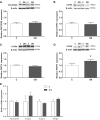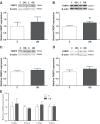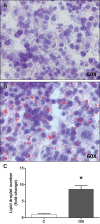Increased placental fatty acid transporter 6 and binding protein 3 expression and fetal liver lipid accumulation in a mouse model of obesity in pregnancy
- PMID: 26491104
- PMCID: PMC4698418
- DOI: 10.1152/ajpregu.00385.2015
Increased placental fatty acid transporter 6 and binding protein 3 expression and fetal liver lipid accumulation in a mouse model of obesity in pregnancy
Abstract
Obesity in pregnancy is associated with increased fetal growth and adiposity, which, in part, is determined by transplacental nutrient supply. Trophoblast uptake and intracellular trafficking of lipids are dependent on placental fatty acid transport proteins (FATP), translocase (FAT/CD36), and fatty acid binding proteins (FABP). We hypothesized that maternal obesity in mice leads to increased placental expression of FAT/CD36, FATPs, and FABPs, and lipid accumulation in the fetal liver. C57/BL6J female mice were fed either a control (C; n = 10) or an obesogenic (OB; n = 10) high-fat, high-sugar diet before mating and throughout pregnancy. At E18.5, placentas and fetal livers were collected. Trophoblast plasma membranes (TPM) were isolated from placental homogenates. Expression of FAT/CD36 and FATP (TPM) and FABP (homogenates) was determined by immunoblotting. Gene expression was assessed by RT-quantitative PCR. Sections of fetal livers were stained for Oil Red O, and lipid droplets were quantified. TPM protein expression of FAT/CD36, FATP 2, and FATP 4 was comparable between C and OB groups. Conversely, TPM FATP 6 expression was increased by 35% in OB compared with C placentas without changes in mRNA expression. FABPs 1, 3-5 and PPARγ were expressed in homogenates, and FABP 3 expression increased 27% in OB compared with C placentas; however, no changes were observed in mRNA expression. Lipid droplet accumulation was 10-fold higher in the livers of fetuses from OB compared with C group. We propose that increased lipid transport capacity in obese mice promotes transplacental fatty acid transport and contributes to excess lipid accumulation in the fetal liver.
Keywords: fatty acid; fatty acid transport protein; maternal-fetal exchange; trophoblast.
Copyright © 2015 the American Physiological Society.
Figures





Similar articles
-
Maternal obesity markedly increases placental fatty acid transporter expression and fetal blood triglycerides at midgestation in the ewe.Am J Physiol Regul Integr Comp Physiol. 2010 Nov;299(5):R1224-31. doi: 10.1152/ajpregu.00309.2010. Epub 2010 Sep 15. Am J Physiol Regul Integr Comp Physiol. 2010. PMID: 20844260 Free PMC article.
-
Alterations in placental long chain polyunsaturated fatty acid metabolism in human intrauterine growth restriction.Clin Sci (Lond). 2018 Mar 15;132(5):595-607. doi: 10.1042/CS20171340. Print 2018 Mar 15. Clin Sci (Lond). 2018. PMID: 29463583
-
Maternal High-Fat Feeding Increases Placental Lipoprotein Lipase Activity by Reducing SIRT1 Expression in Mice.Diabetes. 2015 Sep;64(9):3111-20. doi: 10.2337/db14-1627. Epub 2015 May 6. Diabetes. 2015. PMID: 25948680 Free PMC article.
-
Maternal dietary fatty acids and their roles in human placental development.Prostaglandins Leukot Essent Fatty Acids. 2020 Apr;155:102080. doi: 10.1016/j.plefa.2020.102080. Epub 2020 Feb 21. Prostaglandins Leukot Essent Fatty Acids. 2020. PMID: 32120190 Review.
-
Fetal growth and development: roles of fatty acid transport proteins and nuclear transcription factors in human placenta.Indian J Exp Biol. 2004 Aug;42(8):747-57. Indian J Exp Biol. 2004. PMID: 15573522 Review.
Cited by
-
Maternal sodium butyrate supplement elevates the lipolysis in adipose tissue and leads to lipid accumulation in offspring liver of weaning-age rats.Lipids Health Dis. 2016 Jul 22;15(1):119. doi: 10.1186/s12944-016-0289-1. Lipids Health Dis. 2016. PMID: 27449927 Free PMC article.
-
Effect of maternal high-fat diet on key components of the placental and hepatic endocannabinoid system.Am J Physiol Endocrinol Metab. 2018 Apr 1;314(4):E322-E333. doi: 10.1152/ajpendo.00119.2017. Epub 2017 Nov 14. Am J Physiol Endocrinol Metab. 2018. PMID: 29138223 Free PMC article.
-
MASLD in children: integrating epidemiological trends with mechanistic and translational advances.J Clin Invest. 2025 Jul 1;135(13):e186422. doi: 10.1172/JCI186422. eCollection 2025 Jul 1. J Clin Invest. 2025. PMID: 40590222 Review.
-
Immunometabolic adaptation and immune plasticity in pregnancy and the bi-directional effects of obesity.Clin Exp Immunol. 2022 Jun 11;208(2):132-146. doi: 10.1093/cei/uxac003. Clin Exp Immunol. 2022. PMID: 35348641 Free PMC article.
-
High-fat diet affects pregestational adiposity and glucose tolerance perturbing gestational placental macronutrient transporters culminating in an obese offspring in wild-type and glucose transporter isoform 3 heterozygous null mice.J Nutr Biochem. 2018 Dec;62:192-201. doi: 10.1016/j.jnutbio.2018.09.001. Epub 2018 Sep 13. J Nutr Biochem. 2018. PMID: 30308381 Free PMC article.
References
-
- Abumrad NA, el-Maghrabi MR, Amri EZ, Lopez E, Grimaldi PA. Cloning of a rat adipocyte membrane protein implicated in binding or transport of long-chain fatty acids that is induced during preadipocyte differentiation. Homology with human CD36. J Biol Chem 268: 17,665–17,668, 1993. - PubMed
-
- Adams M, Reginato MJ, Shao D, Lazar MA, Chatterjee VK. Transcriptional activation by peroxisome proliferator-activated receptor gamma is inhibited by phosphorylation at a consensus mitogen-activated protein kinase site. J Biol Chem 272: 5128–5132, 1997. - PubMed
-
- Bionaz M, Loor JJ. ACSL1, AGPAT6, FABP3, LPIN1, and SLC27A6 are the most abundant isoforms in bovine mammary tissue and their expression is affected by stage of lactation. J Nutr 138: 1019–1024, 2008. - PubMed
Publication types
MeSH terms
Substances
Grants and funding
LinkOut - more resources
Full Text Sources
Other Literature Sources
Medical
Molecular Biology Databases
Miscellaneous

